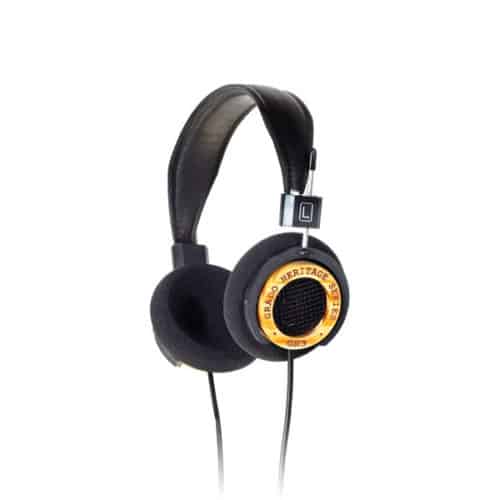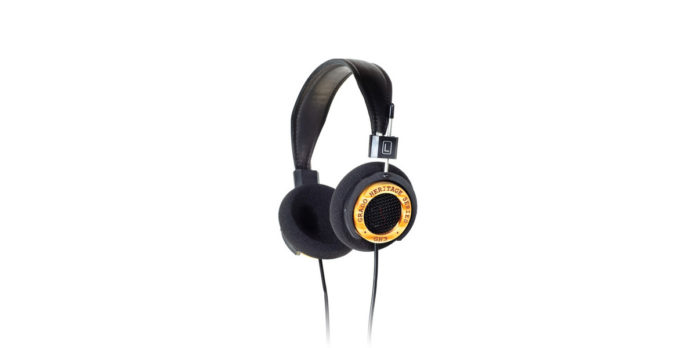Finishing up my pointed look at the new Grado Heritage headphones, today I’m testing out the GH3 – an on-ear headphone with a pine wood housing. At $325, the GH3 marks the first Grado Heritage model with on-ear padding, and the first wood-housing Grado to retail below $495. So how does it sound? And how does this Heritage Grado stack up against its competition?
Grado GH3 Review

The GH3 comes in your standard cardboard Grado box, with a 1/4” adapter and some text about the Grado Saga.
Build-wise, these headphones mirror my current audio idol, the Grado GH4. The GH3 features the same wood housing made from Norwegian Pine, albeit in a smaller form. Departing from other wood and Heritage models, the GH3 features Grado S-Cushions, supplying an on-ear fit.
Cabling includes the thinner 6 ft wire found on models like the RS60e. Despite feeling a little less robust, this does keep the headphones a bit lighter.
And that’s probably the big takeaway regarding the design of the GH3 – low weight. From the minute this headphone touches my ears, I’m pleasantly surprised at how comfortable and airy it feels. Despite the on-ear pads, my giant bat ears accommodate to the form factor, and I’m able to listen for a few hours before I experience any fatigue.
Specifications
Frequency Range: 17-24,000 Hz
Nominal Impedance: 32 ohms
Sound Pressure Level: 99.8
As evidenced by these specs, the GH3 rocks a fairly standard frequency range which should translate to a little extension in the lows and highs. With a low nominal impedance and relatively good SPL, volume shouldn’t be an issue – even without an amplifier. This also allows the GH3 to be used with a low output device, making it perfect for those listening to music on a computer, tablet, or mobile phone.
Low End
Sweet and slightly accentuated (thanks to the Grado S-Cush pads), the low end on the GH3 is deep and luscious – something you can really sink your ears into. Energetic and driving at times, the sound here comes across and powerful and solid. An almost-tangible bass punctuates this part of the frequency range, bestowing a dark edge to an otherwise warm profile.
Midrange
With a good sense of presence, the GH3’s mids strut a fine line between forward and recessed. Meaty and substantial, there’s a ton of detail to be heard here, with relatively good fidelity, to boot. Minor compression may be present in the upper mids, but this is far from a deal breaker; the GH3 seems to do most things right in the midrange, and I’ll take a bit of compression in exchange for the level of detail at this price.
High End
The high end sounds slightly relaxed or smooth, probably stemming from the use of pine in the driver housing (something I also noticed with the more expensive Grado GH4). However, this slightly rolled high end easily compliments the low-end-heavy nature of the GH3. As a result, the high end never seems too peaky or intense, though it can seem a little thin at times. Still, for a smooth, detailed high end, the GH3 knocks the ball out of the park.
Soundstage
Soundstage remains as light and airy as the headphone itself. Displaying a fair amount of depth and placement, the GH3 shines in this department, offering greater clarity and space than other headphones at this price range. This achievement is even further exacerbated by the clean sound and tonal accuracy that comes with a wood housing. Compared to the plastic-housing SR225e or the aluminum-housing SR325e, the GH3 stands apart with cleaner, more accurate headroom.

Other Observations
Bass and lows seem impressively intense. Thanks to the acoustic nature of the pine housing, alongside the use of the Grado S-Cush pads, this headphone rises above my expectations as to just how good a low end can sound. Because this headphone doesn’t just sport a more intense low end, with good bass at the expense of the mids and highs. Instead, Grado has kept most of the detail you’d expect from one of their headphones. They just added some extra pepper to that low end.
Recommendations
For those needing a more dynamic sound (with equal emphasis on highs as well as lows), my money would be on the SR325e at $295. However, this model may come with a bit more distortion than the GH3, so it’s a mixed bag.
If you want a more neutral-sounding headphone without the natural warmth of the GH3, check out the SR225e at $200. As mentioned, you might notice a tad bit more distortion in the sound, but that’s pretty much par for the course for any plastic-housing model.
Honestly, the only real way to improve over the GH3 would be to aim higher in Grado’s lineup; no other manufacturer offers a headphone with this level of clarity and soundstage. Models like the GH4 ($550) and the RS2e ($495) would offer wide-ranging improvement across the spectrum, but at a fairly increased cost.
Final Analysis
With a rich, resounding low end and soundstage that goes on for miles, the Grado GH3 sounds nothing shy of amazing. As the first Grado Heritage model priced at a low $325, it succeeds, too – putting this headphone well within reach of budget-minded audiophiles who want to sample Brooklyn’s iconic headphone brand. Our advice? You could do a lot worse, but not a whole lot better; snag this baby before it’s out of stock.
Get the Grado GH3 for the Best Price Here:
MAJORHIFI may get a commission from retail offers.
MAJORHIFI may receive commissions from retail offers.








